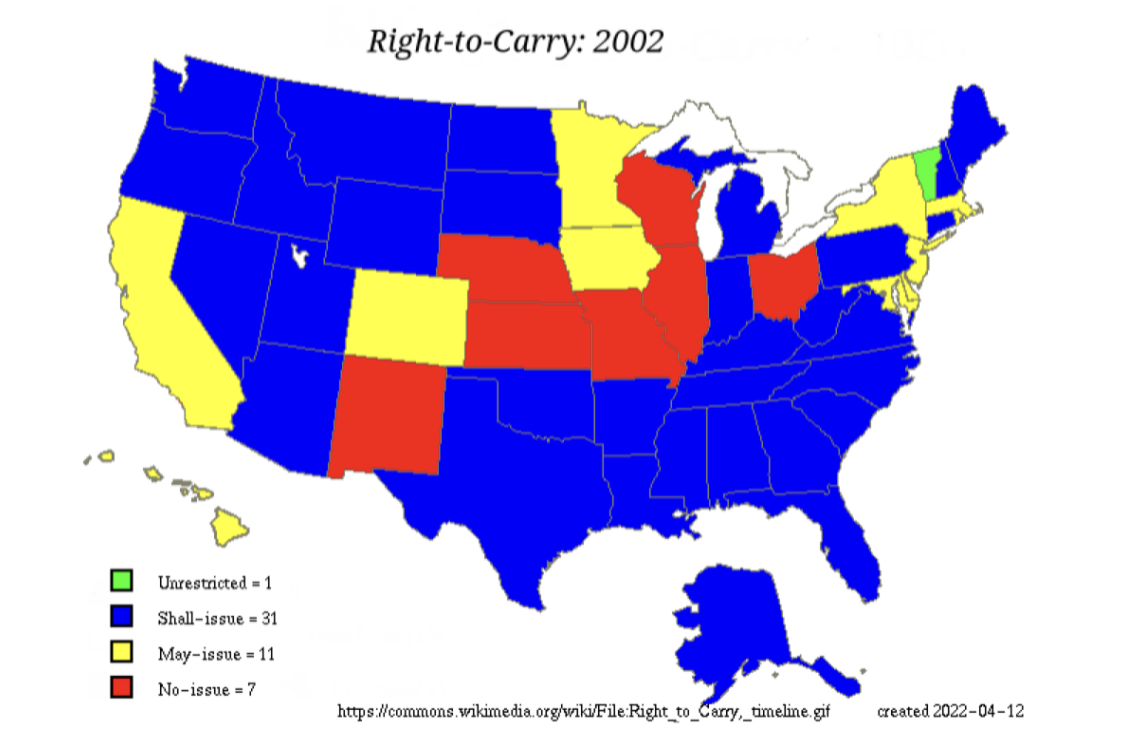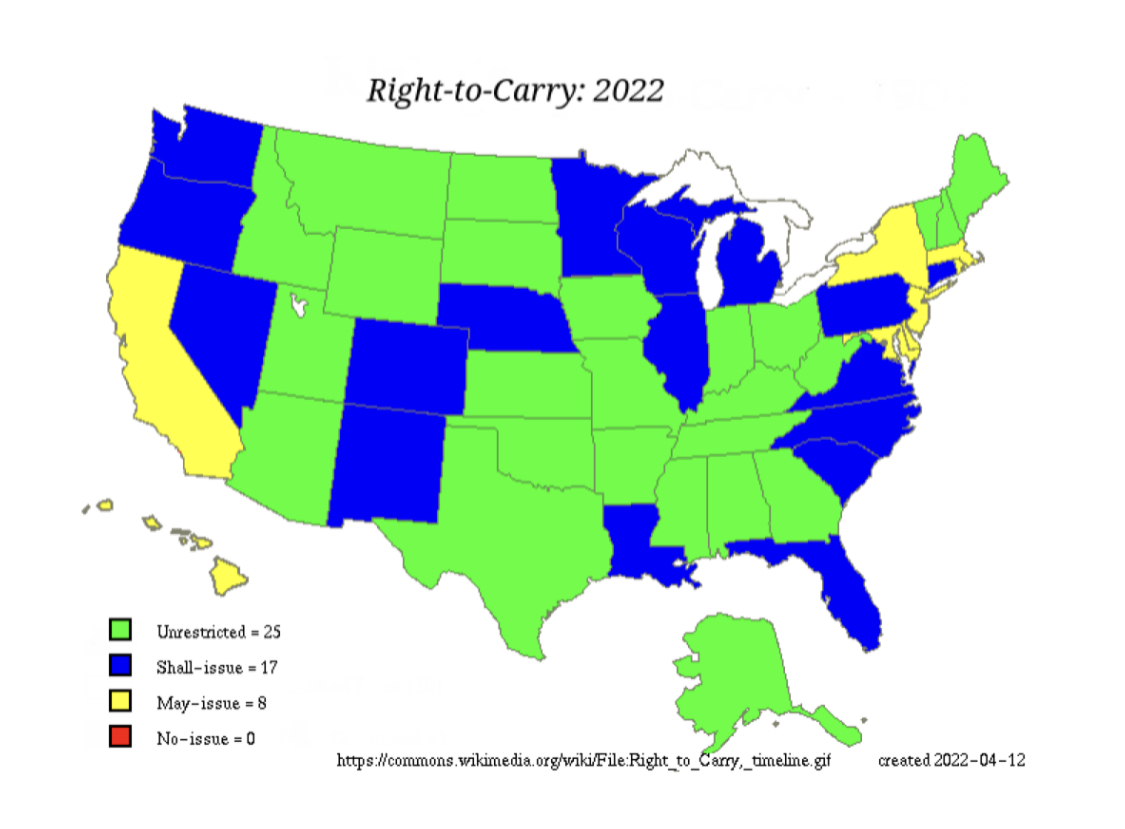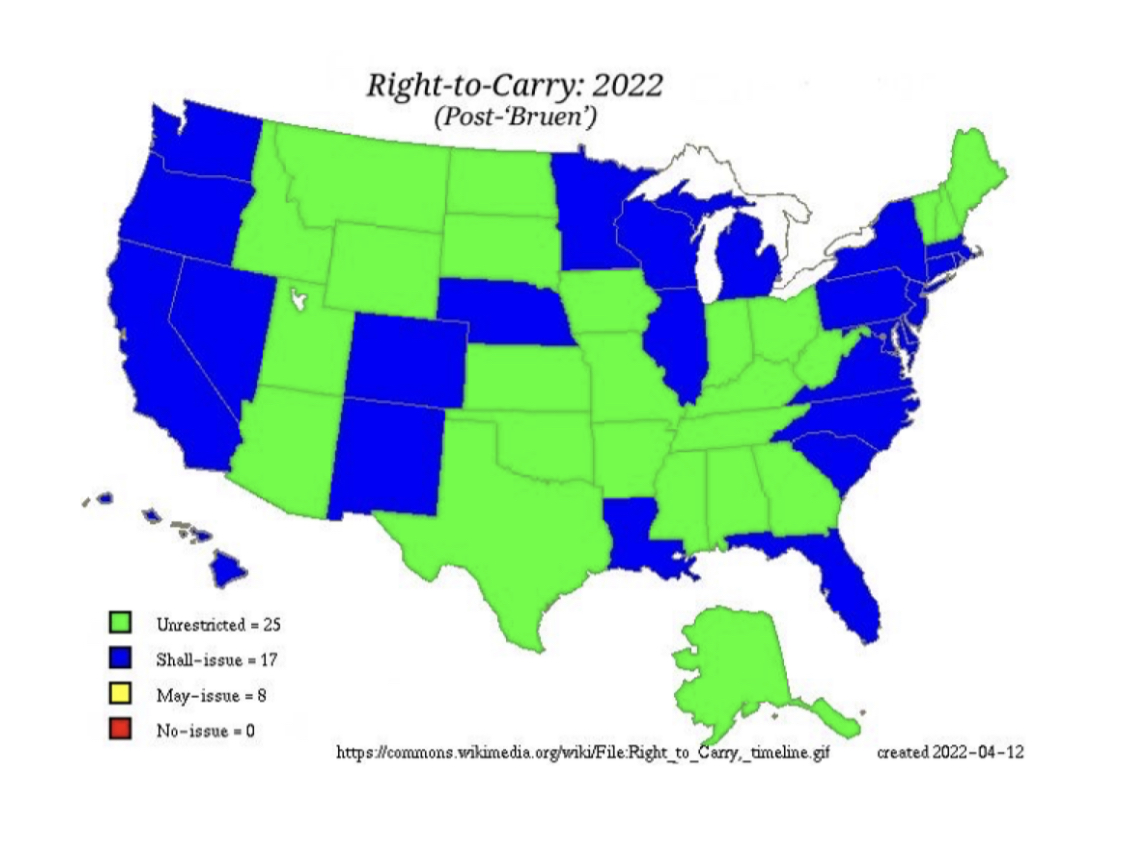Table of Contents

Photo: ‘Bowling for Columbine’
Things have gotten worse. There’s no sense in waiting for the duration of this article to make that clear. Unfortunately, despite ‘Bowling for Columbine’, despite thousands of mass shootings since its release (there were 692 just last year), in spite of everything, things have gotten worse.
Things to do:
- Subscribe to The Hollywood Insider’s YouTube Channel, by clicking here.
- Limited Time Offer – FREE Subscription to The Hollywood Insider
- Click here to read more on The Hollywood Insider’s vision, values and mission statement here – Media has the responsibility to better our world – The Hollywood Insider fully focuses on substance and meaningful entertainment, against gossip and scandal, by combining entertainment, education, and philanthropy.
Michael Moore’s documentary ‘Bowling for Columbine’ turned 20 this year, and despite calling convincingly for a change in attitude to guns, little has been done. Indeed, many gun laws have become looser, and rates of mass shootings have only risen. One loses track of all this, though. These sorts of changes rarely happen all at once – policy shifts glacially, flattening progress in its path. The passion and righteous fury that once stirred hearts is now diluted by disheartenment. It is for this reason that two decades after Michael Moore’s radical and passionate call for change was first released, it is worth taking stock. What did we learn? Did we implement the changes we’d hoped to implement? Did they last? In fewer words, where are we now?
Before any of these questions can be answered, though, it’s essential to recall, clearly and distinctly, what exactly we wanted in the first place. After Eric Harris and Dylan Klebold showed America the worst that misplaced teenage disillusionment and direct access to firearms can produce, what was the response we believed was deserved? Going back and re-watching ‘Bowling’ is like unearthing a time capsule you forgot existed. It’s a vital cultural artifact of a time before mass shootings felt inevitable, where solutions were offered without a weary sense of futility, when change was demanded and often received. Indeed, during the process of making the documentary, Moore succeeded in pressuring KMart into no longer selling handgun ammunition simply by going up and asking them to.
After this, what changes have since occurred can be compared and weighed against the changes needed and desired. Looking separately at the culture of fear and violence and then at national and state legislative levels, the picture may not be pretty. Still, that very hideousness calls out for our renewed attention. In the context of how much time has elapsed since Columbine and indeed ‘Bowling for Columbine’, now is the time to provide that attention.
Related video: Come Behind The Scenes of ‘Elvis’ | Austin Butler, Tom Hanks and Baz Luhrmann
What Was Needed?
‘Bowling for Columbine’ opens with Michael Moore obtaining a free gun from a bank. Later, he purchases ammunition from a barber and talks to a teenager who’s selling firearms for a dollar fifty on the street. Perhaps the most lucidly comprehensible solution the documentary offers is to make guns less available. They should not be available to buy just anywhere, and they certainly should not be available to just anyone. Although mostly attempting to communicate the problems, choosing not to provide explicit policy-based solutions, it’s clear that Moore advocates for tighter gun control than was in place. This is thus one means by which progress can be directly measured.
However, the most central tenet of ‘Bowling’ seems to be the less easily understood idea that a country built upon violence and sustained by fear will inexorably beget a population both preoccupied with and victimized by gun crime and hatefulness. Constant fear-mongering from the media and the glorification of violence by the government and large corporations is inevitably harmful to attempts to maintain peace among American citizens. Moore points towards the presence of Lockheed Martin in Littleton, Colorado, the town where the Columbine school shooting was perpetrated. As the largest defense contractor in the US, it employs many of the town’s inhabitants in manufacturing weaponry. Moore contends that this engendered some level of normalization of institutionalized violence within the town and likely produced, at least in part, the kind of people who could commit such a crime as Eric Harris and Dylan Klebold. This is not such an easy issue to remedy, and it’s not particularly simple to measure our progress in moving away from this situation. Nevertheless, some comparisons can be made: are the same mechanisms for fear-mongering still in place? Is military spending still too high? Is this still affecting people’s mindsets? These are questions that can be asked and somewhat answered.
WATCH: Do People In USA Support Gun Control? – Hollywood Insider’s “Messages From America” – Episode 5
Gun Control – Culture of Fear and Violence
‘Bowling for Columbine’ directed much blame at the American news media and its fear-mongering tactics used to gain greater viewership at the expense of social harmony. Racist coverage, alarmist selectiveness of stories, and propagation of moral panic were all tactics pointed out by the film. Although it’s nearly impossible to establish whether or not news coverage has improved, it is hard to see why it would have. With the incentives the same, the techniques as effective as ever, and nothing done to solve the issue by the government, the problem likely remains in a similar state. Regardless, this seems hardly relevant in evaluating whether or not a culture of fear persists nowadays, given the advent of social media.
Related video: Come Behind The Scenes of ‘Elvis’ | Austin Butler, Tom Hanks and Baz Luhrmann
With much more effective, endless, and widespread forms of communication, the same emotionally manipulative stories have now been able to find more potent outlets. A Harvard Business School study found, from an analysis of 140,358 tweets from 44 news agencies in 2020, that negative sentiment was not only 15 percent more common than positive sentiment, but it garnered more engagement too. Given these statistics and the fact that social media (mainly Twitter and Facebook) has become notorious for constant negative news, it seems hard to argue that fear-mongering has improved. If anything, the situation is more dismal than ever, with the most powerful fear-mongering tools produced now in the hands of anybody who wants them.
The dizzying ‘What a Wonderful World’ montage sequence of ‘Bowling’, featuring a series of violent American interventions abroad, constitutes a bold critique of America’s history of war-waging. This history, Moore argues, is connected to the violence America experiences at home. America has long had a problem with oversized military budgets, and 2002 was no exception, with 3.2 percent of GDP going to defense, a total of 348.456 billion. According to the 2023 budget, spending for 2022 is estimated to reach roughly 766 billion, or 3.2 percent of GDP. In this case, although matters have not gotten worse, it is a shame to see that the same amount of money is being funneled towards violence as it ever was.
Related article: WATCH: Do People In USA Support Gun Control? – Hollywood Insider’s “Messages From America” – Episode 5
Most disconcertingly, one of the most expensive military projects currently being undertaken is the production of F-35 aircraft, which Lockheed Martin won the contract for in 2001. Slated to be a cheaper option than alternatives at the time, the project is now expected to cost an estimated 1.727 trillion over its predicted 50-year duration. The planes are being constructed at Lockheed’s Fort Worth, Texas base. Nearby, Moore’s theory of normalizing institutionalized violence has been proven consistent. Less than an hour’s drive from where these F-35 aircraft are being put together, on September 10th, 2017, Meredith Lane and her friends were sitting in her yard in Plano, waiting for the Dallas Cowboys’ first game of the new season to begin. By the final whistle, nine bodies lay cold and bloodied on the grass, eight dead. Meredith’s ex-partner had returned and shot her, as well as all of her friends. The deadliest shooting in the city’s history, this event is nothing if not confirmation of the idea that violent institutions imbue violence in their communities.
Prison Reform: To End Police Brutality, Ban Private Prisons
Related video: Full Rendezvous at the World Premiere of ‘Thor: Love and Thunder’ | Chris Hemsworth, Natalie Portman
Related video: Full Commentary – Cast & Crew Spills Secrets on Making of ‘Thor: Love and Thunder’ | In-Depth Scoop
If the impact of American military action is not clear enough, though, then the 2009 Fort Hood shooting makes it patent. On November 5, at Fort Hood army base, 13 soldiers were killed, and 30 were injured by military psychiatrist Nidal Hasan. As a product of the military and its actions, his motives are telling. He had told family that he didn’t feel comfortable working for an army that killed Muslims. According to The Dallas Morning News, the shootings might have been caused in part by Hasan’s disappointment or anger in failing to convince superiors to prosecute some of his patients for war crimes they’d told him they’d committed during therapy with him. He was intensely affected by what his patients had told him and was thus terrified of his upcoming deployment in Afghanistan. If any shooting can stand as a testament to the legacy of institutionalized violence, it is this; a tragedy wherein the very cause was a mental break derived from an inability to cope with the wars one’s country is waging. America’s violence abroad does not excuse or explain Hasan’s actions, but it undeniably contributed to his state of mind at the time of his crimes.
Unfortunately, it seems with regard to the cultural and social status of fear and violence, circumstances have only gotten worse. Indeed, it was just over two months ago and only a half day’s drive from Fort Worth that the Robb Elementary School shooting in Uvalde occurred. The shooter had bought his weapons a week before the event on the day after his 18th birthday – he wasn’t yet considered responsible or mature enough in the eyes of the government to wield a can of Heineken, and yet he had the right to bear arms. Accordingly, the next question that must be asked rears its head: has gun-control improved?
Related article: Prison Reform: To End Police Brutality, Ban Private Prisons
National Level Legislation
It would be easy to skip forward twenty years to the present – to June 23rd, 2022 – to ‘New York State Rifle & Pistol Association, Inc. v. Bruen’. “Cut to the chase,” you might say, understandably frustrated with the recent SCOTUS decision. Of course, ‘Bruen’ is a massive step in the wrong direction, and it disrupts many of the achievements made by gun-control activists in preceding years. Still, it would be wrong to say it undoes them. To gloss over everything else that’s happened since 2002 would be to ignore, perilously, the story these years tell. ‘Bruen’ did not come out of nowhere; it was the consequence of years of erosion: attrition-based policy-making, the momentum of which inevitably became too much to be contained to small chips away at gun control. It only takes a few small victories before one gets the idea to come for the whole kingdom. ‘Bruen’ is the final chapter of a story that should be told in order, starting in 2002, when US gun rights barely resembled what they do today (Fig. 1).
 Caption: (Figure 1) 2022 Map of US Gun Law, Originally created by Jeff Dege, CC BY-SA 3.0
Caption: (Figure 1) 2022 Map of US Gun Law, Originally created by Jeff Dege, CC BY-SA 3.0
Related article: MUST WATCH – The Hollywood Insider’s CEO Pritan Ambroase’s Love Letter to Black Lives Matter – VIDEO
The story of post-‘Bowling’ change most likely begins with 2003’s Tiahrt Amendment, which significantly restricted the Bureau of Alcohol, Tobacco, Firearms, and Explosives in its ability to share information from its firearms tracing database. Though law enforcement can still receive information for criminal investigations,
academics can no longer gain access to the bureau’s data for use in research about gun crime. Any data released to the public legally can no longer be employed in civil lawsuits against firearm manufacturers and vendors. Admittedly, this was a rather
technical and minor step back, but it fundamentally conveys a preference for protecting weapons companies at the expense of the public good. This preference was further cemented by George W Bush’s 2005 ‘Protection of Lawful Commerce in Arms Act’, which stated that in neither federal nor state civil suits could relevant firearm producers be named by gun-crime victims. This allowed gun manufacturers to sell firearms to whoever they like within the scope of the law, regardless of apparent danger, without risk of being sued.
It wasn’t until 2008 that another substantial change occurred on the national stage. ‘District of Columbia v. Heller’ seems at first glance to be another rather academic piece of legislation until its practical contexts are considered. Establishing for the first time that the Second Amendment represents an “individual right to possess a firearm unconnected with service in a militia,” ‘Heller,’ in theoretical terms, was merely a clarification. Indeed, it merely confirmed the most common (though perhaps inaccurate) interpretation of the constitution as guaranteeing the right to bear arms for self-defense, not just for state militias. Nevertheless, in practical terms, it ruled D.C.’s ban on handguns unconstitutional, setting a hugely significant precedent for the future, which was two years later applied to the rest of the country with ‘McDonald v. City of Chicago,’ thus making handgun bans impossible nationwide. It’s difficult to overstate how detrimental this decision was to the hope of limiting deaths from guns. If America wants to reduce gun crime and mass shootings significantly, handguns are central to this. With 59 percent of gun murders and non-negligent manslaughters executed by handguns in the US in 2020, handgun bans are evidently necessary, or at the very least a reasonable step, towards fixing the problem at hand.
In another Supreme Court case, ‘Caetano v. Massachusetts,’ the court concluded in 2016 that the right to bear arms included all weapons that one could bear, not just those in existence at the time of writing the Second Amendment. This ruling was intended to allow the possession of stun guns by citizens directly but indirectly closes an avenue for potential legislation on other modern weapons, such as assault rifles.

Caption: (Figure 2) 2022 Map of US Gun Law, Originally created by Jeff Dege, CC BY-SA 3.0
That was six years before ‘Bruen.’ Now that the Supreme Court has announced its ruling, these smaller decisions over the last score of years sharpen into focus – not as isolated decisions or moments in judicial history that push the needle to one direction or the other, but as sustained pressure from one direction. In ‘New York State Rifle & Pistol Association, Inc. v. Bruen,’ the court established two things. Firstly, it declared that states could not ban the carrying of guns in public, though they may regulate it in certain ways. In other words, the right to bear arms extends to public spaces, not just within the home. Perhaps more importantly, SCOTUS also clarified that a New York law demanding that gun buyers demonstrate a “special need for self-protection” violated the constitution. This fact had avoided the court’s notice for the 109 intervening years since the law’s inception.
This ruling is incredibly troubling, more so than any other SCOTUS ruling on gun control since the release of ‘Bowling for Columbine.’ State approaches to gun control are often classified as either ‘unregulated,’ ‘shall-issue,’ ‘may-issue,’ or ‘no-issue,’ in ascending order of strictness. While may-issue states will give out guns to those with permits depending on apparent need, shall-issue states give out guns to all those meeting basic permitting requirements. ‘Bruen’ renders may-issue regulation all but impossible to meaningfully maintain. This decision constitutes a devastating blow to the gun-control cause. There were already only eight may-issue states left (Fig. 2) compared to 11 in 2002, but it seems that number will now dwindle to zero (Fig. 3), meaning the entire country will now have access to guns so long as they meet basic standards, and some even without those restrictions.

Caption: (Figure 3) Potential 2022 Post-‘Bruen’ Map of US Gun Law, Originally created by Jeff Dege, Edited, CC BY-SA 3.0
Unsurprisingly, these changes have accumulated over time and have had noticeable effects on crime statistics. The BBC reported that in 2020, over 45,000 US citizens were killed by guns, including murders and suicides, the highest number ever recorded. Indeed, this is a 43 percent increase since 2010. Unfortunately, ‘Bruen’ will likely manifest itself similarly concerning statistics in coming years too. Though the recent ‘Bipartisan Safer Communities Act’ is a positive step, its minor improvements cannot stand up to the weight of the past twenty years of backward momentum. Strengthening background checks for those gun buyers under 21, funding red flag laws at a state level, and closing loopholes is fantastic, but it’s not nearly enough.
Related article: The Hollywood Insider’s CEO Pritan Ambroase: “The Importance of Venice Film Festival as the Protector of Cinema”
Related article: The Masters of Cinema Archives: The Hollywood Insider Pays Tribute to ‘La Vie En Rose’, Exclusive Interview with Director Olivier Dahan
Related article: – Want GUARANTEED SUCCESS? Remove these ten words from your vocabulary| Transform your life INSTANTLY
State Level Legislation
If this progression – from a national gun-crime emergency to far looser gun-control – still feels abrupt, it’s because, arguably, the vast majority of the tug of war between gun control and free reign on guns has been conducted at a state level.
For instance, some states which have been hit particularly hard by gun violence have responded harshly. Connecticut, where Sandy Hook, the deadliest school shooting in US history occurred, is one such example. It’s a story of implementing appropriate gun control, albeit only after an unimaginably hard lesson. Lawmakers described the changes as perhaps “the toughest gun laws in the country.” This wasn’t wholly true, but they were substantially stricter and more robust than before. New regulations included a high-ammunition magazine ban, an expanded assault weapon ban, and improved registration systems for magazines and guns, as well as a law that serial numbers must be engraved on all manufactured guns. Connecticut also instituted a dangerous weapon offender database, apparently the first of its kind in the country. Fortunately, other states also learned from Sandy Hook without having to wait for their own local tragedies to occur. New York, for instance, ensured with NY SAFE that all assault rifles must now be registered. Though there is much to be pleased about with these developments, it must be asked why tragedy is required to force change. Furthermore, why must the disaster happen within a 150-mile radius to induce this change? Sandy Hook happened in America, not just in Connecticut or the Northeast; it should spur the entire nation to upheaval, not just a cross-section of those most affected.
Meanwhile, in states either less touched by gun violence or more in favor of gun rights, things have been getting far worse. For example, nearly half of all US states now have a ‘take your gun to work’ law, meaning you can bring a firearm to your place of work and leave it in your car outside (or, in some cases, bring it inside). These are practically all post-‘Bowling’ laws. Florida introduced their ‘take your gun to work’ law in 2008, Indiana in 2010, and Texas in 2011, with a host of other states doing likewise.
More shockingly, many state legislatures have responded to tragedy or anticipated it by loosening gun laws. If enough good people in the right places have guns, it will cancel out the less good people with guns in those same places. In recent years, this thinking has often been extended to schools and colleges. In 2012, Kentucky ruled that their ‘take your gun to work’ law was held for universities too. Even more shocking is that Texas passed a law in 2017 stating that public colleges must allow concealed carry around campus buildings. They are not alone, though. Eleven states have similar laws mandating colleges allow students to carry guns on campus. Twenty-three others leave it up to the discretion of the institution.
Schools were the obvious next target for gun rights proponents. September 2014 saw bill SB 656 allow Missouri school employees to carry concealed guns in school after receiving special training. Most horrifying of all is that at the time, they were the 10th state to do this after Sandy Hook. More have joined them now, with Florida introducing similar laws in 2018 and 2019.
Related article: A Tribute to Johnny Depp: The Actor and Musician Who Defined Range
Related video: EVOLUTION: Every Johnny Depp Role From 1984 to 2020, All Performances Exceptionally Poignant
Related article: A Tribute to the Hero & President Volodymyr Zelenskyy: Comedian/Actor, Ukraine’s President and Heroic Leader
In the most drastic of cases, states have taken matters into their own hands and sought to paralyze any present or future attempts to regulate guns permanently. Idaho went especially far in asserting via bill HB 69 that gun control is unconstitutional, making it illegal for any funding or resources to contribute to enforcing national gun regulations. Some would claim that this 2014 law goes as far as nullifying federal policy, but either way, it’s an unmistakably severe step to take. Nevertheless, Kansas went just as far the same year with HB 2578, declaring all local firearms regulations invalid, even going as far as to ban police departments from destroying firearms after they cease to be required as evidence.
Having said all this, it would be wrong to assume that little or no progress has been made. The prevailing wind blows in the direction of gun rights, but there has been a considerable amount of resistance. A Colorado law came into force on July 1st, 2013, which made firearm buyers pay for their background checks and banned the purchasing of magazines that can hold more than 15 bullets. Unfortunately, magazines of this kind bought before this date can be kept. This has roused concern for the practical viability of this law since large magazines purchased before the ban don’t need to be registered, and magazines are not serially numbered. This makes it incredibly tough to demonstrate that a large-capacity magazine was purchased after the ban.
Maryland had a more definitive success with a 2013 piece of legislation that prohibited selling assault weapons and large capacity magazines, as well as mandating that handgun owners pass a training course and be fingerprinted. Those committed to a mental institution against their will were also forbidden to own weapons. Later that year, certain semi-automatic weapons and magazines for semi-automatic weapons were banned, too, though those who already owned them could keep them.
Related article: We Must Talk About Brittney Griner: Where Is The Public Outrage?
Related article: Master Spiritual Teacher Michael J Tamura: How To Heal Yourself? – 5 Step Self-Healing Path Back To YOURSELF
One matter that almost the entire country could agree on was bump stocks; a device used to transform a semi-automatic gun into a fully automatic. After the 2017 Las Vegas shooting where a bump stock was used, New Jersey and New York soon banned them. Delaware, Hawaii, Maryland, Washington, Washington D.C., Massachusetts, and others soon followed suit. In the end, the government banned them altogether. This kind of rapid change, if replicated for other gun-law issues, could spell real, momentous progress. Nonetheless, success was likely found in this instance since most gun rights activists agree about bump stocks. After all, even Wayne LaPierre, CEO and executive VP of the NRA, has spoken out against bump stocks.
California, which it makes sense to discuss last, constitutes a gun-law phenomenon of its own kind. A battleground fiercely fought on either side; it is maybe the only place in America where the pressure for gun-control has truly been a force to be reckoned with in the last two decades. In this way, California is a case study of what can be achieved when gun-control advocates at a state level fully mobilize, simultaneously illustrating the much greater strength of national gun rights advocates. One big success was 2015’s Firearm Safety Certificate (FSC) program. This updated system extended all prerequisites for handgun purchases to every other type of firearm. Similarly, a 2021 bill extended the one-handgun-every-30-days regulation to all other firearms. In addition, from 2024 onwards, ‘firearm precursor parts’ must be sold through licensed dealers.
Simultaneously, California has seen historical failures. Since 1923, gun vendors have not been allowed to advertise that they sell handguns on their property. After 95 years, this law’s tenure was cut short, when in 2018, this law was struck down and declared unconstitutional. To have a law that has stood for that much time be invalidated demonstrates the power those against gun control can muster when necessary.
One of the most closely fought battles occurred in Peruta v. San Diego (2014). This case asked whether or not a ‘good cause’ restriction on concealed carry was constitutional. The court initially decided that it was not and that concealed carry was protected by the second amendment – a victory for gun rights. However, the decision was then heard en banc, and the decision was reversed – a comeback for gun control. After an appeal from the other side, the decision was reconsidered but kept to the en banc verdict – a massive success for gun-control. This is why NYSRPA v. Bruen (2022) represents such a failure. As perhaps the most stable may-issue state in the country, it stands as a great injustice that after so much work put in through local government, state government, and the courts to keep gun control in place, the power of the national gun rights movement was able to override all of this. California, ‘post-Bruen,’ is now shall-issue.
Related article: Facebook: Like-Fueled, ILL-Regulated Politically-Charged Abusive Machine
Related article: Many In The Entertainment Industry Speak Out Against The SCOTUS Abortion Ban
Related article: Do More Than Just “Cancel” Actors That Commit Sexual Assault, Start Firing Them
‘Bruen,’ of course, did not just hamper the efforts of California gun-control activists. In 2012, the Second Circuit Court of Appeals ruled New York’s “special need for self-protection” as lawful through their decision in Kachalsky v. County of Westchester. This, once again, was a huge step forward. It wasn’t to last, though, since ‘Bruen’ struck it down. To see so much hard-fought progress within a state dwarfed by enormous national pressure from gun rights forces is utterly disheartening. This form of intervening-from-above has been common and is not exclusively federal-to-state, either. The Wisconsin Supreme Court, for example, would not allow the city of Madison to sustain its law prohibiting guns on public buses.
California remains a salient illustration, though. Despite its failures, its successes speak of the strides that can be made when a motivated group of gun-control supporters mobilizes. There is still ground to be won, too. To take just one such pending battle, on June 4th, 2021, California’s assault weapons ban was ruled unconstitutional. However, an indefinite stay of appeal was granted, meaning the original decision is not applied yet, and a new verdict will eventually be announced. With letter-writing, funding, and other forms of activism, these kinds of results can be pushed in a certain direction – this is necessary.
Final Thoughts
The original purpose of this article was to discern what had changed since 2002, when ‘Bowling for Columbine’ was released. It seems hardly necessary to remark that this has ceased to be the purpose. The question which now most pleads an answer is “why has the situation worsened?”
Related article: Southern Baptist Convention Releases Previously Secret List Of Sexual Abusers Within The Church
Related article: Social Media Effect On Capitol Riot As Explained By Social Media Insularity Effect
Related article: The History Of, And Trouble With, Police Stories In Pop Culture
A 2017 Politico poll showed that 64 percent of Americans wanted tighter gun-control laws, while only 29 were against this. Indeed, this seems to have been the case almost as far back as memory stretches. Even in 1980, conditions were such that Tom W. Smith could claim that “one of the few constants in American public opinion over the last two decades has been that three-fourths of the population supports gun control” and sound utterly modern. In ‘Disarmed: The Missing Movement for Gun Control in America’ (2006), Kristin Goss asks the following question: “most people want strict gun control, but they don’t get it. Why?” It is indeed a question worth asking since the reason that gun law has loosened since ‘Bowling’ is not due to a lack of support for gun control from the public.
The answer, Goss argues, is that there is “no real gun-control movement in America.” Regrettably, the facts back this idea up. According to a 2019 Harvard study, Republicans present 48 percent more pieces of firearm legislation in the period following a mass shooting than in other years, while Democrat activity changes by a statistically insignificant amount. Goss explains this effectively by noting that membership in organizations supporting gun-control numbers less than a tenth of that of the NRA. There simply isn’t as much active support for gun control as for gun rights. The problem with this is that the NRA uses the money it raises from its many members to push political action. This sort of strategy works. As Goss puts it, “America’s political system, with its multiple layers and divided powers, favors committed and well-organized groups such as the NRA, even if only a small minority of citizens embrace their views.” Such is the problem; a majority is insufficient if it is not mobilized. America is a democracy of voices, not of people – and money, as ever, talks the loudest. It doesn’t help that advocates for gun rights are statistically more likely to donate money or write letters to support their cause than those arguing for gun control.
Related article: Must-Watch: The Complete Analysis Of The Horrifically Cruel Conservatorship Torturing Britney Spears | #Freebritney
Related article: The Case Of Being Born Black In The American South, Black People Edition
Related article: The Real Hero: Wentworth Miller – First Hollywood Leading Man To Accept Only Gay Roles
Still, one might argue that given all the tragedies which have befallen the United States since ‘Bowling,’ it is surprising that even a galvanized support base for gun rights has persisted in easing the restrictiveness of gun laws. Such an argument ignores, however, that for most people in support of this cause, widespread gun ownership is the solution to the nation’s mass shooting crisis. Once again, data appears to confirm this. The earlier-cited Harvard study of 2019 found that in states with Republican-controlled governments, a mass shooting leads to a 115 percent increase in laws enacted which loosen gun regulations (for Democrat-run states, no statistically significant change occurs). Consequently, it appears clear that US gun law has become more lenient not in spite of the enormous proliferation of mass shootings across the US, but because of it. For each mass shooting that occurs in a red state, regulations generally get eased, and for each shooting that occurs in a blue state, nothing generally changes. Inevitably, this lop-sidedness accumulates over time, shifting not just state law, but eventually gathering so much momentum that federal law, too, is affected by the strength of the gun rights cause.
The terrible fact is that giving people guns does not stop mass shootings. New York Times data, collected between 2000 and 2021, showed that of the 433 known active shooter attacks that have occurred in that time, only a paltry 2.8 percent ended with a ‘good guy with a gun’ (an armed citizen) saving the day. That’s 12 out of 433. In contrast, 42 of the events were stopped by a citizen subduing the attacker without resorting to firing a gun. In the words of one interviewee in ‘Bowling for Columbine,’ “if more guns made people safer, then America would be one of the safest countries in the world. It isn’t”.
To fix this, more must be done both to control new guns and to save people from the guns they already own. The latter of these points is often forgotten. As long as people who have always had guns continue to have them, they will continue believing they need them. Only once they are taken away will they realize they can exist without them. Guns are a safety blanket for many Americans, and they need to be torn away from their clutching arms en masse if there is going to be any real momentum gathered in the right direction. There are so many firearms out there that even banning the production of new guns, however good of a policy, would hardly put a damper on the supply.
Related article: The Independence Of Carl Nassib: The First Openly Gay NFL Player – A Touchdown For The LGBTQ+ Community
Related article: Black Mothers Join Politics After Innocent Sons Killed By Police Brutality
Related article: If Oscars New Rules Had Existed 80 Years Ago, These Deserving Stars Would Not Have Been Ignored
The gun-control cause has had successes, albeit very few outright ones. Gun rights politicians have frequently passed pieces of sweeping legislation that utterly change the landscape of gun law within the state or even the nation. Such unqualified successes are seldom seen by proponents of gun control. Progressive bills are rarely passed without being made partially ineffectual, substantially diluted, or in some cases, utterly gutted. Doubtless, twenty years ago, most would have expected politicians to do better. As Eric Hynes put it for Criterion, “that a topical documentary film can remain relevant and instructive sixteen years after its release speaks to Moore’s prescience as well as to the depths of America’s moral decay.” Four years later and the story is the same. Few do not feel utterly dismayed by the national response to what now stands as twenty decades of the ongoing, accelerating massacre.
A demoralized Moore told Criterion, “I think we hoped that something good would come out of it. What came out of it was then nearly two more decades of Columbine after Columbine after Columbine”. The BBC reported that between 1968 and 2017, there have been 1.5 million firearm deaths: more than all the soldiers killed in every US conflict since the 1775 War of Independence. Americans are at war with each other, and the government is both condoning and possibly profiting from the marketing of the tools of this war. If the promise of progress once stirred by ‘Bowling’ is ever to be fulfilled, now is the time: gun-control advocates must raise their level of support to that of gun rights supporters.
Director: Michael Moore | Editor: Kurt Engfehr
Writer: Michael Moore | Composer: Jeff Gibbs
Producers: Michael Moore, Jim Czarnecki, Michael Donovan, Wolfram Tichy, Tia Lessin, Kathleen Glynn, Charles Bishop
By Samuel Sandor
Click here to read The Hollywood Insider’s CEO Pritan Ambroase’s love letter to Cinema, TV and Media. An excerpt from the love letter: The Hollywood Insider’s CEO/editor-in-chief Pritan Ambroase affirms, “We have the space and time for all your stories, no matter who/what/where you are. Media/Cinema/TV have a responsibility to better the world and The Hollywood Insider will continue to do so. Talent, diversity and authenticity matter in Cinema/TV, media and storytelling. In fact, I reckon that we should announce “talent-diversity-authenticity-storytelling-Cinema-Oscars-Academy-Awards” as synonyms of each other. We show respect to talent and stories regardless of their skin color, race, gender, sexuality, religion, nationality, etc., thus allowing authenticity into this system just by something as simple as accepting and showing respect to the human species’ factual diversity. We become greater just by respecting and appreciating talent in all its shapes, sizes, and forms. Award winners, which includes nominees, must be chosen on the greatness of their talent ALONE.
I am sure I am speaking for a multitude of Cinema lovers all over the world when I speak of the following sentiments that this medium of art has blessed me with. Cinema taught me about our world, at times in English and at times through the beautiful one-inch bar of subtitles. I learned from the stories in the global movies that we are all alike across all borders. Remember that one of the best symbols of many great civilizations and their prosperity has been the art they have left behind. This art can be in the form of paintings, sculptures, architecture, writings, inventions, etc. For our modern society, Cinema happens to be one of them. Cinema is more than just a form of entertainment, it is an integral part of society. I love the world uniting, be it for Cinema, TV, media, art, fashion, sport, etc. Please keep this going full speed.”
More Interesting Stories From The Hollywood Insider
– Want GUARANTEED SUCCESS? Remove these ten words from your vocabulary| Transform your life INSTANTLY
– A Tribute to Martin Scorsese: A Complete Analysis of the Life and Career of the Man Who Lives and Breathes Cinema
– Do you know the hidden messages in ‘Call Me By Your Name’? Find out behind the scenes facts in the full commentary and In-depth analysis of the cinematic masterpiece
– A Tribute To The Academy Awards: All Best Actor/Actress Speeches From The Beginning Of Oscars 1929-2019 | From Rami Malek, Leonardo DiCaprio To Denzel Washington, Halle Berry & Beyond | From Olivia Colman, Meryl Streep To Bette Davis & Beyond
– In the 32nd Year Of His Career, Keanu Reeves’ Face Continues To Reign After Launching Movies Earning Over $4.3 Billion In Total – “John Wick”, “Toy Story 4”, “Matrix”, And Many More
gun control, gun control, gun control, gun control, gun control, gun control, gun control, gun control, gun control, gun control, gun control, gun control, gun control, gun control, gun control, gun control, gun control, gun control, gun control, gun control, gun control, gun control, gun control, gun control, gun control, gun control, gun control, gun control, gun control, gun control, gun control, gun control, gun control, gun control, gun control, gun control, gun control, gun control, gun control, gun control, gun control, gun control, gun control, gun control, gun control, gun control, gun control, gun control, gun control, gun control, gun control, gun control, gun control, gun control, gun control, gun control, gun control, gun control, gun control, gun control, gun control, gun control, gun control, gun control, gun control, gun control, gun control, gun control, gun control, gun control, gun control, gun control, gun control, gun control, gun control, gun control, gun control, gun control, gun control, gun control, gun control, gun control, gun control, gun control, gun control, gun control, gun control, gun control, gun control, gun control, gun control, gun control, gun control, gun control, gun control, gun control, gun control, gun control, gun control, gun control, gun control, gun control, gun control, gun control, gun control, gun control, gun control, gun control, gun control

Outside of his ongoing MA degree in English and Philosophy at St Andrews, Samuel Sandor spends his spare hours writing – short stories, essays, articles on film, music, or any other subject he finds himself preoccupied by. Through all these strands, he strives to find a unique and unexpected way to look at the subject at hand. Without a concerted effort, it’s easy to form surface-level impressions of both the art and the news that one consumes. Sam’s pieces attempt to answer this interpretative simplicity by inducing curiosity in subjects one might ordinarily devote little thought to. It is this desire to transform viewpoints with novel ideas and to stoke deeper and more extensive conversations which attracted him to The Hollywood Insider.








